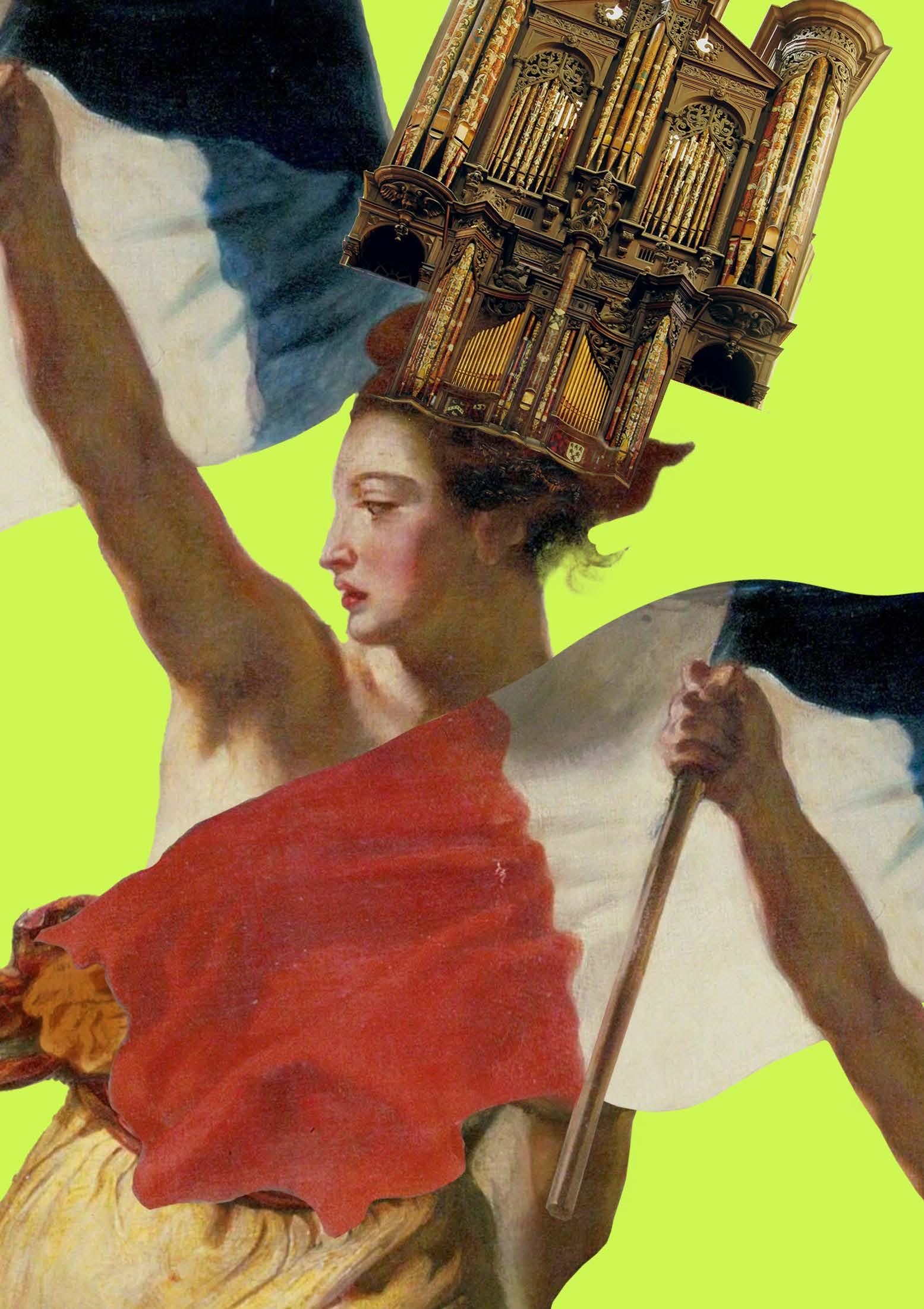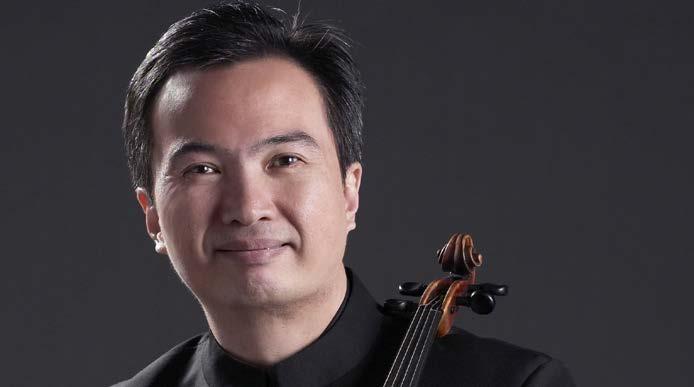15 Apr 2023, 7.30pm
Victoria Concert Hall
Sponsored by

CONCERTO DE L’ADIEU
PROGRAMME
Koh Jia Hwei organ
re: mix
Foo Say Ming music director, violin
HOWELLS
3 Psalm Preludes Set 1, Op. 32
I. Psalm 34 v. 6
VIERNE
24 Pièces en style libre, Op. 31
IV. Épitaphe
XXIV. Postlude
Organ
8 mins
solo
9 mins Organ solo
Andante
7 mins re: mix
RESPIGHI Chaconne 10 mins Organ and re: mix
Concerto
11 mins Organ and re: mix
TCHAIKOVSKY
Cantabile
VITALI arr.
DELERUE arr. CHEN ZHANGYI
de l'Adieu (Farewell Concerto)
CONCERT DURATION: approximately 1 hour (with no intermission)
Jia Hwei started learning the organ in 2013 with Dr. Evelyn Lim. She continued her studies with Susan Landale and Gerard Brooks at the Royal Academy of Music in London (UK), where she was the recipient of the Joyce Rhoda Danzelman Award, Eric Windo Organ Award, and Stephen Bicknell Organology Prize. During her graduate studies in London, she was organ and choral scholar at St. Michael’s and All Angels in Croydon, and organist at St. Mary’s in Acton. She was awarded her Masters in performance in 2019.
Originally, Jia Hwei majored in piano at the Royal Northern College of Music in Manchester (UK), where her tutors were Jeremy Young and Carole Presland. She graduated with her Bachelors and subsequently Masters of Music in 2003. She won a number of awards during her studies at the RNCM, including the Rawsthorne Prize, the Bach Recital Prize, and the Prix Scarbo.
She is now based in Singapore and plays regularly for the VCHpresents Organ Series. She continues to work as soloist and chamber musician with local orchestras, such as the Singapore Symphony Orchestra, re:Sound, Red Dot Baroque; and also with the Yong Siew Toh Conservatory of Music.
 KOH JIA HWEI organ
© Timothy Teo
KOH JIA HWEI organ
© Timothy Teo
RE: MIX
re: mix, an ensemble of classically trained musicians who reckons that classical music is in need of transformation, to mould with the times and gain contemporary relevance for it to engage its audience. Led by violinist and music director Foo Say Ming, re: mix comprises Singapore’s finest local and international chamber musicians.
re: mix firmly believes that classical music must expand beyond its roots and explore new boundaries. It is necessary to engage and connect with other art forms such as dance, film, architecture, amongst others, and in the process not only become a testimony to what emerges from this interaction, but also inspire a new
RE: MIX MUSICIANS
MUSIC DIRECTOR
Foo Say Ming
FIRST VIOLIN
thinking of the other disciplines through active cross-pollination. re: mix, too, seeks to champion new works of local composers.

Apart from re: mix’s own concert projects, charity events and outreach programmes, it receives regular invitations to perform locally and in the region. re: mix has toured Malaysia, Indonesia, Thailand, Hong Kong and Taiwan, appearing in special intercountry/cultural events and various music festivals.
It’s 2 CDs, “Introducing re: mix” and “Wild And In Love” has garnered the accolades of “Best CD of the year” by Straits Times, in 2012 and 2018 respectively.
Lim Shue Churn
Wu Bing Ling
Chew Lu Min
Loh Lit Wung
Hong Yaw Chang
SECOND VIOLIN
Ye Zhi
Tang Tee Tong
Leow Gim Ann
Shawn Lim
VIOLA
Keita Suyama
Matthias Oestringer
Darius Goh
CELLO
Lin Juan
Chen Chia Min
Lu Han Wei
DOUBLE BASS
Wang Xu
FOO SAY MING
re: mix Music Director
At the 4th National Music Competition in Singapore (1983), Singapore violinist Foo Say Ming walked away with the 1st prizes of the Violin (Open) the Ensemble (Open) Categories, and the grand prize of the competition: the Best Performer Award unanimously awarded by the judging panel, a feat which has yet to be equalled in the history of the country’s music competition.
Say Ming continued his studies at the Royal College of Music (London,
Philharmonic and the BBC Symphony Orchestra, and the Conservatoire de Lausanne (Switzerland), with French violinist Pierre Amoyal, a protégé of Jascha Heifetz.
In addition to his performing commitments, Say Ming works closely with aspiring young musicians, notably with talented musicians in the Singapore National Youth Orchestra, in the capacity of Tutor and Assistant Conductor with the NUS Symphony Orchestra, and as Head Of Strings at NAFA, a position he held from 2012-2022.
He leads and direct re: mix, a unique chamber ensemble which has gained attention in its exploration of new repertoire of its genre. re: mix’s debut CD – “Introducing re: mix”, and its 2nd CD “Wild and In Love”, received raving reviews and was picked by The Straits Times Life! as CD of the Year in 2012 and 2018 respectively.
Say Ming has been a first violinist with the Singapore Symphony Orchestra since 1990.


The music of Chen Zhangyi has been described as “music from a voice of
the future” by BBC Radio 3 and “a breath of fresh air on our musical landscape” by The Straits Times. Nature is an important source of inspiration in his instrumental and orchestral works, such as Vanda, Rain Tree and Of An Ethereal Symphony. In his dramatic works such as the chamber opera cycle A Singapore Trilogy, he often explores the musical representation of Singaporean culture. Chen teaches Analysis and Composition at Yong Siew Toh Conservatory of Music. As a violist, he performs with Red Dot Baroque.
PROGRAMME NOTES
HERBERT HOWELLS (1892 – 1983)
3 Psalm Preludes Set 1, Op. 32
I. Psalm 34 v. 6
Howells was born in Gloucester, in the south-west of England. Showing early promise in music, he won a scholarship to study at the Royal College of Music in London.
Howells wrote two sets of Psalm Preludes, each corresponding to the respective World Wars. The first set was written at around 1915 or 1916, at a time of Howell was diagnosed with Grave’s Disease, an autoimmune disorder which – happily, for the musical world – was to prevent him from being conscripted into the army to fight in WW1, and facing an uncertain fate. Such was the destiny of many of his friends studying with him then, at the RCM in London.
Although a youthful work, this tonepoem bears all the hallmarks of his individual style – Tudor Elizabethan polyphony, French impressionism, and the dissonance of the twentieth-century. Dedicated to his tutor at the RCM, Sir Walter Parratt, Howells describes its arc-like form:
“A student’s shy tribute to a great Organist and Teacher. Structurally it is an essay in slow, prolonged, cumulative development of climax, followed by an equally unhurried descent dismissing and eliminating complexity, movement, sonority”
Howells defied the doctors’ poor prognosis of six months – and went on to live a full life until the age of 91. Unlike a chorale prelude, which sets words of a hymn text to music, each of the Psalm Preludes meditates on the mood of a specific Psalm verse. In this case, the supplication of the Psalmist offers assurance in the face of adversity
“
Lo, the poor man crieth and the Lord heareth him; yea, and saveth him out of all his troubles.” Psalm 34:6
LOUIS VIERNE (1870 – 1937)
24 Pièces en style libre, Op. 31 IV. Épitaphe XXIV. Postlude
Vierne was born in Poitiers, a western region of France. His life was beset by a number of tragedies – he was born with congenital cataracts, and his marriage and subsequent romantic relationships marked by betrayal and abandonment. His son Jacques and brother René were both killed in action in the First World War in 1917.
Like many composers after Johann Sebastian Bach’s Well-Tempered 48 Preludes and Fugues (notably, the preludes of Chopin, Scriabin, and Alkan) Vierne’s 24 Pièces en style libre encompass the twelve major and minor keys, each bearing a title in the style of a romantic character piece. They date from 1913–1914, at the cusp of the outbreak of WW1.
The Epitaphe is from Livre 1, which bears no dedication, and the Postlude from Livre 2, which names a dedicatee for each piece. The Postlude, an extended improvisation in two sections, is dedicated to Vierne’s student at the Conservatoire de Paris, Émile Poillot.
Vierne held the post of organist titulaire at the Notre Dame Cathedral from 1900 until his unfortunate death at its console, whilst improvising during his 1750th recital. His assistant, another great French organist, Maurice Duruflé (1902–1986), was by his side.
Programme notes by Koh Jia Hwei
PYOTR ILYICH TCHAIKOVSKY (1840 – 1893)
Andante Cantabile
Tchaikovsky’s 1st String Quartet is one of the highlights of his small chamber output. It is filled with melody and strikes a fine balance between his curiosity for the Classical style and his own natural Romanticism. When it was first performed it was a success and rescued him from dire financial straits; the string orchestra arrangement followed later as the slow movement gained fame in its own right.
The melody that begins this movement is commonly known as the “Song of the Volga Boatmen”, which Tchaikovsky heard at his sister’s house in Kamenka. He sets the melancholy melody very simply, with shifting inner lines for viola. The modal harmonies of the opening give way to the incredible warmth of the second theme later, in D flat major — a melody so lovely that it was used for a 1940s popular song (“On the Isle of May” by Connee Boswell). After the Volga song comes back in a richer setting, the warm second theme is set over a heartbeat-like pizzicato pulsing in the lower strings, giving the end of the movement an air of sweet intimacy.
TOMASO ANTONIO VITALI (1663 – 1745)
arr. OTTORINO RESPIGHI (1879 – 1936)
Chaconne
This Chaconne has been the subject of much musico-historical speculation. No extant original manuscript exists for this work, and, as a work attributed as far back as the Baroque period, was only published as late as the 1860s, when Ferdinand David included an arrangement in a violin teaching book. While it does have the typical descending bass line that Baroque chaconnes have, it also has several very unusual chromatic key changes, which suggest Romantic-era tampering. The earliest copy even has an erroneous attribution (to a “Tomaso Vitalino” who
does not exist!) and Vitali’s name was close enough that the piece has since been largely attributed to him. Regardless of its history, it has a firm place in the violin repertoire, mostly in its violin-and-piano form, featuring a wide range of accompanimental textures supporting a virtuosic violin line. Respighi’s arrangement is even more restrained than his other treatments of Baroque music (in the three sets of “Antique Airs and Dances”) and the piano material is very gently distributed across the string ensemble and organ.
GEORGES DELERUE (1925 – 1992)
arr. CHEN ZHANGYI (b. 1984)
Concerto de l’Adieu (Farewell Concerto)
Concerto de l’Adieu was written for a war movie (Điên Biên Phu) by film composer Georges Delerue, which depicted the last days of French Indochina in the run-up to the Vietnam War. The movie featured a star cast and the music thus fell to “the Mozart of cinema”, as Le Figaro called Delerue.
A soaring melody full of pathos emerges after a dramatic opening in a dark minor key. Delerue, in writing the Concerto, stayed with very simple harmonic progressions over syncopated chordal accompaniments, with the end result resembling the slow movements of popular violin concerti. Some sunlight and hope come with the turn towards a major key and a faster accompaniment from the orchestra, though the emotional intensity never lets up throughout. This is music designed to stir the sentiment: after the battle of Điên Biên Phu in 1954, the French colonial army would soon withdraw from Vietnam.
Programme notes by Thomas Ang
PATRON SPONSOR SUPPORTED BY sso.org.sg/ VCHpresents VCHhomeofthesso VCHpresents

 KOH JIA HWEI organ
© Timothy Teo
KOH JIA HWEI organ
© Timothy Teo



